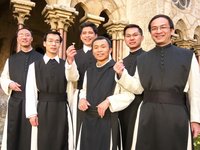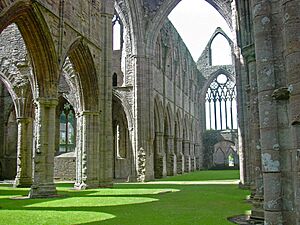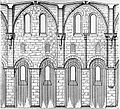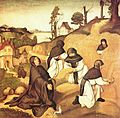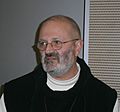Cistercians facts for kids
|
(Sacer) Ordo Cisterciensis
|
|

Coat of arms of the Cistercians
|
|
| Abbreviation | OCist or SOCist |
|---|---|
| Formation | 1098 |
| Founder | Bernard of Clairvaux; Robert of Molesme, Stephen Harding, and Alberic of Cîteaux |
| Founded at | Cîteaux Abbey |
| Type | Catholic religious order |
| Headquarters | Piazza del Tempio di Diana, 14 Rome, Italy |
|
Abbot General
|
Mauro-Giuseppe Lepori |
|
Parent organization
|
Catholic Church |
The Cistercians are a group of Catholic monks. Their official name is Ordo Cisterciensis (OCist). They follow a set of rules created by Saint Benedict long ago.
Over time, some other monks, called Benedictines, changed these rules. But the Cistercians wanted to go back to the original, stricter way of life. They believed in hard work, especially farming. This focus on manual labor helped spread new farming methods across Europe in the Middle Ages. In 1882, a new group called the Trappists formed from some Cistercian monasteries. Eventually, they became a separate order.
Contents
What Are Cistercians?
The Cistercian Order began in 1098 at Cîteaux Abbey in France. They are known for their simple lifestyle. Monks live in monasteries and spend their days praying, working, and studying.
Their Way of Life
Cistercian monks live a very disciplined life. They focus on prayer, silence, and hard work. They often work in fields, growing their own food. This helps them to be self-sufficient. Their simple life is meant to help them focus on their faith.
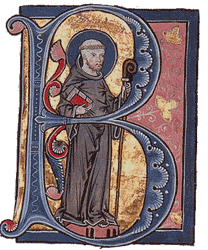
Building Beautiful Monasteries
Cistercians are also famous for their buildings. Their monasteries and churches are known for being very simple and pure in style. They are often considered some of the most beautiful buildings from the Middle Ages. They avoided fancy decorations. Instead, they focused on strong, clear designs.
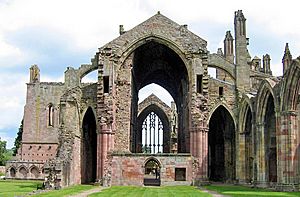
How Cistercians Helped Towns Grow
A study from 2016 looked at how Cistercian monasteries affected towns in England. It found that places near Cistercian monasteries grew faster and became more productive from the 1200s onwards. This positive effect continued even after the monasteries were closed in the 1530s. Some people think this happened because the Cistercians' way of life, with its focus on hard work, helped local economies.
Images for kids
-
An old drawing of Stephen Harding presenting a model of his church to the Blessed Virgin Mary.
-
Saint Benedict and Saint Bernard (1542), by Diogo de Contreiras. Saint Bernard is shown in the white Cistercian robe.
-
The ruined Mellifont Abbey, an important Cistercian site in Ireland.
-
Rievaulx Abbey, which was taken by Henry VIII.
-
The simple style of Cistercian architecture at the 12th century Royal Monastery of Santa María de Veruela.
-
Vaux-de-Cernay Abbey in Yvelines, France.
-
The detailed 14th-century tomb of Peter I of Portugal in Alcobaça.
-
Cistercians at work, from a painting about the Life of St. Bernard of Clairvaux.
-
Cistercian monks in Lourdes.
-
Prioress of the Cistercian abbey of Saint Mary of Rieunette near Carcassonne, France.
See also
 In Spanish: Orden del Císter para niños
In Spanish: Orden del Císter para niños


